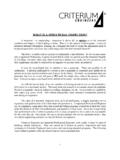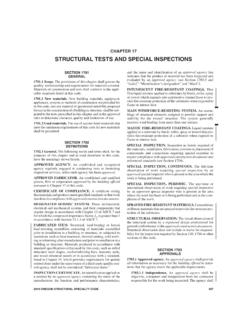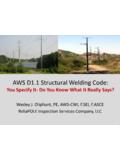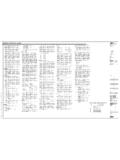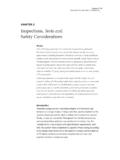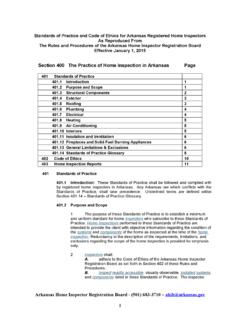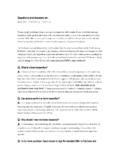Transcription of Structural Inspections of Masts and Towers - MATS …
1 GN-014. Structural Inspections of Masts and Towers Issue : November 2015. Review date : November 2016. MATS Group Guidance Note Structural Inspections of Masts and Towers 1 Introduction The purpose of this document is to provide guidance on Structural Inspections for tower and mast owners (transmission and radio). It will describe the principles of Inspections and provide general guidance for their completion. The tower or mast owner should manage the estate in such a manner that the risk of injury to employees, subcontractors and the general public is minimised as far as is reasonably practicable. There is no single document that specifies what constitutes an acceptable through-life estate management practice to minimise risk levels as far as is reasonably practicable.
2 It is recognised that some tower and mast owners have stringent in-house processes and procedures for the inspection of their Towers , built up over a number of years' experience and assessment of risks within their estates. This document does not detail these in-depth company policies and procedures but provides guidance on the minimum recommended requirements to other companies which may not have similar regimes in place. It also clarifies areas of ambiguity relating to responsibilities for inspection on sites that are shared with third parties. The guidance draws on what is accepted as the minimum requirements by recognised tower and mast owners and by British Standards where they exist.
3 Note that individual companies/infrastructure owners may choose to operate more stringent or more frequent inspection regimes than are recommended in this Guidance Note. 2 Scope This document provides guidance on the requirements for inspecting Masts and Towers (transmission and radio) within the UK. It also identifies responsibilities for Inspections where equipment is installed on a third party site. It assumes that the structure was originally built to the required standards and that the design of new structures and appraisal of existing structures, concerning both the derivation of environmental loading conditions and the determination of Structural response, are undertaken in accordance with current British Standards and Euronorms and in line with industry best practice.
4 Relevant standards for design and appraisal are listed below: Guyed Masts BS EN 1993-3-1. Towers BS EN 1993-3-1 in conjunction with Annex B to PD6688-1-4, which is due for publication in December 2015. Monopoles BS EN 40 or PLG07 (Professional Lighting Guide 07 published by the Institution of Lighting Professionals). This guidance also assumes that further Structural review, potentially including full analysis of the structure, will have been undertaken in the following circumstances: prior to use of the structure or a proposed change of use of the structure, incorporating additional apparatus or equipment on the structure.
5 Following an incident in which significant damage or Structural distress has occurred. by recommendation following a previous technical inspection . This document does not provide details of how to climb the structure safely to undertake the inspection , and assumes that the persons undertaking the inspection are competent to complete the inspection safely. Issue : November 2015 MATS Group Guidance Note GN-014 page 2 of 9. Review date : November 2016 Structural Inspections of Masts and Towers 3 Competent persons A technical inspection should be carried out by, and certificates signed by, a competent person. A. competent person should: have a minimum of three years' collective relevant experience in the inspection and construction of the type of structure involved, or have attended a Structural inspection course to obtain relevant information on the specific structures in order to conduct an inspection adequately.
6 If only the latter is the case, there must be robust internal procedures and additional expertise in place as a back-up to provide further advice and experience as required. have the appropriate level of climber competency to operate safely on the structures involved. (See MATS Guidance Notes GN-001 Work at Height Training and GN-012 . Climbing Masts and Towers .). Each tower and mast owner will have a person/team in place to oversee the inspection regime and assess its effectiveness in identifying issues and ensuring that these issues are resolved in a satisfactory manner. This person/team will either have the following competency or access to following competency: a suitably qualified Structural engineer.
7 4 Structural Inspections The objectives of the technical inspection are to undertake a safety audit and to determine whether the structure is in a satisfactory condition and to ensure that the form of access and places of work are fit for purpose and comply with statutory requirements. If possible/available, obtain a copy of the previous Structural condition report or safe to climb certificate prior to inspection . This may prove to be a valuable source of information or reference basis for comparison while conducting the Structural inspection . 5 inspection Frequency Fundamentally the frequency with which a structure is inspected is determined within Standard BS8100, which states that Class A & B Towers inspection periods should not exceed 2 and 5 years respectively, or that inspection should take place if the conditions laid out in the scope of this Guidance Note regarding change of use or Structural damage apply.
8 Although BS8100 has been withdrawn, and there is no similar reference to inspection frequency in its successor BS EN 1993-3-1, it is anticipated that similar inspection guidance may be provided in the yet to be released NCCI document PD 6695-3-1. Owners of all structures should ultimately seek advice from the manufacturer on the frequency of Inspections . However the manufacturer's opinion may be regarded as guidance only' if owners can provide sufficient records and risk assessmen4ts to demonstrate that alternative frequencies can be used, and still provide adequate safe integrity of the structure factors including: Previous maintenance records if consistently no issues have been raised over various Inspections this may extend the inspection frequency.
9 Age as the structure gets older the inspection frequency may need to increase. Loadings structures where there is little or no information on their loading status or which are known to be highly loaded, 95% of its design criteria, may need more frequent Inspections . Location structures in populated areas may need to be inspected more frequently than those in very rural areas; also structures in very exposed conditions (wind, rain, sea) may need inspecting more frequently than those in sheltered areas. Areas where there are high levels of vibration from external sources. Issue : November 2015 MATS Group Guidance Note GN-014 page 3 of 9.
10 Review date : November 2016 Structural Inspections of Masts and Towers Whatever decision is made, the frequency inspection should not exceed BS8100 guidelines and the decision should be made by persons with the competence to assess all the required information and determine a suitable inspection frequency. Owners may determine that a fixed inspection regime is required across their portfolio, all sites inspected 2 yearly. If this approach is taken the frequency should be based on manufacturers' data together with knowledge of the structures being inspected, including age, use and locations to ensure a suitable assessment has been made.

